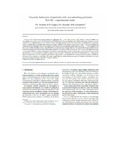Viscosity behaviour of particles with non-adsorbing polymers Part III—experimental study
Date
2004Author
Goodwin, J.W.
Hughes, R.W.
Reynolds, P.A.
Kwaambwa, H.M.
Publisher
Elsevier B.V. www.elsevier.com/locate/colsurfaType
Published ArticleMetadata
Show full item recordAbstract
A series of well characterised cis-poly(isoprene) (PIP) polymers (Mw = 1180, 8000, 28 300, 31 500, 86 000, 115 000 and 130 000) have
been added to dispersions of poly(12-hydroxystearic acid) (PHS) coated poly(methylmethacrylate) (PMMA) particles in dodecane. The ratio
of particle size to adsorbed layer was also varied. For a given added polymer molecular weight, the polymer concentration in the continuous
phase covered the dilute, semi-dilute and concentrated regimes as defined by the critical concentrations c and c . The viscosity behaviour
of latex dispersions with added polymer were similar for all latex/polymer combinations except when polymer Mw = 1180 was added. In the
latter case, the effect of adding polymer reduced both the viscosity and shear thinning behaviour. This supports the contention that the lower
molecular weight polymer acts more like a diluent than a depletent. The behaviour of the viscosity ratio (the viscosity of the dispersion relative
to that of the medium) as a function of polymer concentration increased with an increase in the polymer concentration until some critical
concentration (cmax) for all polymers except for a polymer molecular weight 1180 Daltons. The addition of the polymer Mw = 8000 gave the
highest viscosity ratio values in the polymer concentration range studied. It was found that the viscosity of all latex/polymer combinations
decreased with an increase in temperature. The results suggest that the viscosity behaviour cannot be explained on the basis of a simple
steric–elastic model and require a modified theoretical treatment.

